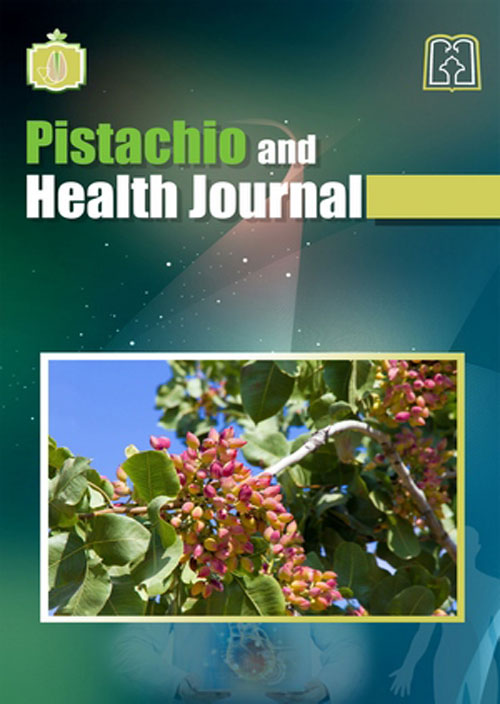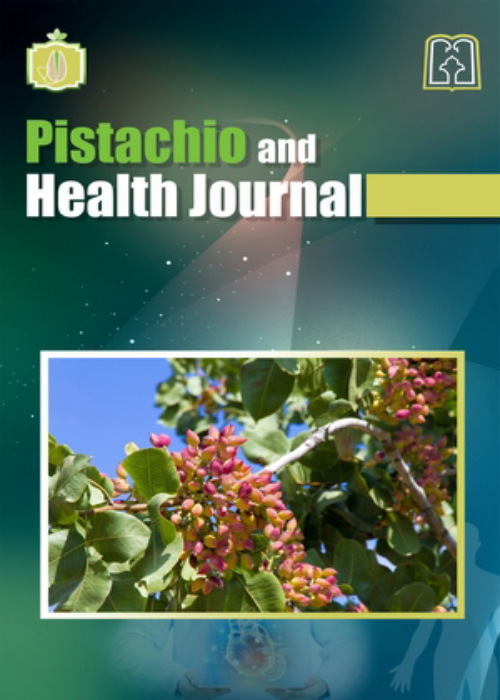فهرست مطالب

Pistachio and Health Journal
Volume:2 Issue: 1, Winter 2019
- تاریخ انتشار: 1397/11/12
- تعداد عناوین: 8
-
-
Pages 1-9Introduction
Polycystic ovary syndrome (PCOS) is associated with many complications. Neurobehavioral deficits are reported in women with PCOS. Patients with PCOS show a high risk for affective disorders, which impair the quality of life. Finding a safe herbal medicine for these complications is valuable. Pistacia vera plays a beneficial role in central nervous disorders. The current study is designed to evaluate the effects of Pistacia vera oil on depression and anxiety-like behaviors in female rats with letrozole-induced PCOS.
MethodsLetrozole (1 mg/kg) was used orally in order to induce PCOS. Pistachio oil (1 and 4 ml/kg) was administered with letrozole. After 21 days, elevated plus-maze test, forced swimming test (FST), and open field tests were performed.
ResultsThe data showed that the PCOS condition led to immobility time enhancement in the FST (P<0.001). PCOS animals significantly exhibited anxiety-like behaviors (P<0.05). Treatment with pistachio oil with doses of 1 and 4 ml/kg completely blocked the deleterious effects of PCOS on behavioral parameters.
ConclusionPistacia vera oil could alleviate depression and anxiety in rats with PCOS.
Keywords: Pistacia vera, Polycystic ovary syndrome, Anxiety, depression, Rat -
Pages 10-21Introduction
Fenitrothion is one of the common pesticides used in pistachio orchards. Although strict rules have been laid down for the use of sustainable organic pollutants, they are still detected in natural water.
MethodsIn this work, highly ordered mesoporous titanium dioxide (TiO2 mesoporous) with large pore size and high surface area, iron (II, III) oxide nanoparticles (Fe3O4) and graphene oxide (GO) was successfully fabricated and GO-Fe3O4/TiO2 (GFT) mesoporous nanocomposite proposed as a heterogeneous photocatalyst. The physicochemical and morphology, properties of GO-Fe3O4/TiO2 mesoporous were characterized by field emission scanning electron microscopy with energy dispersive X-Ray spectroscopy (FESEM-EDS), transmission electron microscopy (TEM), X-ray diffraction (XRD), and specific surface area by the BET method.
ResultsThe GO-Fe3O4/TiO2 mesoporous showed a good photocatalytic activity for the degradation of fenitrothion, achieving almost complete removal of 6 ppm fenitrothion after 60 min contact with 0.06 g/L of the nanocatalyst in nutral pH. The degradation of fenitrothion was found to follow the pseudo-first order according to kinetic analysis.
ConclusionGO-Fe3O4/TiO2 mesoporous is a recyclable catalyst that effectively degrade fenitrothion pesticide in aqueous media.
Keywords: GO-Fe3O4, TiO2 nanocomposite, pesticide, Fenitrothion, photocatalyst, Mesoporous Material -
Pages 22-28Introduction
Pistachios are among the major horticultural products in Iran. The production of strong seedlings is required to give a high crop yield.
Materials and MethodsA hydroponic culture medium was used in this study to control the environmental conditions of cultivation more effectively. For this purpose, pistachio seeds, from Badami Zarand cultivar, were planted in 18 pots, with each pot containing 3 seeds. Two quantities of 5 and 25 mM calcium acetate were added to a modified Hoagland solution in a hydroponic culture medium. Next, 60 ppm of 6-benzylaminopurine was sprayed 3 times per 2 weeks on 9 pots, including 3 replications of treatments. As a result, 6 treatments were produced, including a blank one, calcium 5, calcium 25, 6-benzylaminopurine, 6- benzylaminopurine and calcium 5, as well as 6-benzylaminopurine and calcium 25. After 4 months, the seedlings were harvested, with some growth factors, including stem height, stem diameter, as well as root and shoot dry and wet weight measured.
ResultsThe effects of 6-benzylaminopurine were significant on most of the mentioned growth factors, except seedling height. There were different results concerning the treatments of the 2 amounts of calcium acetate, in which calcium 5 as well as 6-benzylaminopurine and calcium 5 yielded better results. In the end, the best treatment was determined to be 6-benzylaminopurine and calcium 5.
ConclusionAccording to the results of this study, using calcium at low concentrations is useful for the growth of pistachio seedlings. In addition, using growth regulators improves growth factors, such as root dry and wet weight as well as stem diameter. Applying the findings of this study could be useful in producing stronger plants under stressful conditions.
Keywords: Calcium, 6-Benzylaminopurine, Pistachio Growth Factors -
Pages 29-39Introduction
Pistacia vera (pistachio) is a strategic crop in Iran. Some stressors, such as pathogen invasion, drought and salinity negatively affect pistachio growth and production. Chemical methods which have been employed for a long time, can be a serious threat to the environment and human health. Establishing appropriate symbiosis between pistachios and beneficial microorganisms of soil has recently attracted a lot of attention, which could replace chemical methods.
ResultsMycorrhizal fungi are among the most common symbionts of pistachios. These fungi increase the root surface for the uptake of water and some immobile elements, especially phosphorous. Trichoderma is a free-living fungus which can establish symbiosis with pistachios to protect them against different soil pathogens, apart from having some nutritional benefits. Some soil-borne bacteria can also provide symbiosis with pistachio roots as plant growth-promoting rhizobacteria. They improve plant growth by increasing the uptake of some elements, such as phosphorous, iron, and zinc, in addition to producing some phytohormones.
ConclusionScreening and selecting the most suitable symbionts is a major step in providing useful symbiosis between pistachios and soil microorganisms. Co-inoculation with several compatible microbes could also be a good solution for benefiting plants and overcoming environmental stresses. However, it needs more investigations.
Keywords: Mycorrhizae, Pistachio, Rhizobacteria, Symbiosis, Trichoderma -
Pages 40-52Introduction
Improving the growth characteristics of pistachio trees has always been of great importance. The present study aims to evaluate the effects of different levels of putrescine and its precursor arginine on some nut characteristics and physiological parameters of pistachio trees in ‘Owhadi’ cultivar.
Materials and MethodsPistachio trees were treated with putrescine 0, 0.1, and 0.2 mM as well as arginine 0, 300, and 600µM at two stages (the green tip and the tight cluster of the bud) in a factorial experiment based on a randomized complete block design (RCBD) with 4 replications.
ResultsAccording to the results, putrescine and its precursor arginine decreased the physiological disorders of pistachios and increased the crop yield. In addition, putrescine and arginine decreased the percentage of inflorescence bud abscission, fruit abscission, fruit deformation, as well as early splitting and indehiscent shells compared to the control treatment. In both ‘on’ and ‘off’ years, the effects of putrescine and arginine were greatly dependent on both the time of application and the concentrations used. According to the results, the exogenous application of these compounds, especially at the tight cluster stage of buds, increased indehiscent shells and the crop yield in both ‘on’ and ‘off’ years. The exogenous application of arginine at the tight cluster stage of buds decreased the abscission of inflorescence buds and other physiological disorders, but it increased indehiscent shells and the crop yield, especially arginine 600µM at the tight cluster stage of buds.
ConclusionIt seems that arginine plays a key role in the growth and development of vegetative and reproductive characteristics in pistachios.
Keywords: arginine, pistachios, Putrescine, crop yield -
Pages 53-61Introduction
Plant probiotic bacteria are a group of microorganisms that enhance plant growth and protect plants against many diseases by several mechanisms; they can also be used as biofertilizers.
Materials and MethodsIn this study, the ability of Bacillus subtilis strains (VRU1 and BS-VRU) to produce siderophore, IAA, and some enzymes, such as cellulase, lipase, protease, as well as their potential biocontrol against Phytophthora drechsleri, the causal agent of crown and root rot in pistachios, were evaluated in vitro. In addition, the effects of these bacterial strains on growth parameters, such as fresh and dry weights of shoots and roots, plant height, as well as the biocontrol of P. drechsleri were investigated under greenhouse conditions.
ResultsAccording to the results of this study, two strains were able to produce siderophore, IAA, lipase, cellulas, and protease. Greenhouse results showed that both strains of B. subtilis increased growth parameters significantly in inoculated plants compared to the control. In addition, the results obtained showed that these bacterial strains decreased the mortality rate of pistachio seedlings, with the highest and lowest reductions having been 75% and 50% in VRU1 and BS-VRU, respectively.
ConclusionAccording to the results, pistachio gummosis could be controlled by Bacillus subtillis bacteria. In addition, B. subtilis VRU1 and BS-VRU showed high efficacy in the suppression of diseases through several biocontrol mechanisms.
Keywords: Bacillus subtilis, biological control, Cellulose, Phytophthora, Drechsleri, Siderophores -
Pages 62-70Introduction
Due to the presence of pesticide residues in agricultural products, the security and safety of foods have taken on close attention. Cheilomenes sexmaculata (Fabricius) (Coleoptera: Coccinellidae) is a principal biological control agent in pistachio orchards, especially against Agonoscena pistaciae Burckhardt and Lauterer (Hemiptera: Psyllidae) that is the most damaging pest of pistachio. It is an effective predator to be used as a bio-control agent, which can reduce the use of pesticides in integrated pest management (IPM) program.
Materials and MethodsIn this project, the side effects of spirotetramat and abamectin were evaluated on C. sexmaculata by dipping the egg stage into the pesticide concentrations. Spirotetramat was tested at three concentrations of 100, 50, and 25 mg/L, representing 2/1, 1/1, and 1/2 of the maximum field recommended concentration (MFRC). Abamectin was also tested at a dilution series of 1/1, 1/2, 1/4, 1/8, and 1/16 of its MFRC, corresponding to 9, 4.5, 2.25, 1.12, and 0.56 mg/l, respectively.
ResultsEgg hatching was significantly reduced when eggs were exposed to all concentrations of insecticides except at 1/2 MFRC of spirotetramat. The results of the present project revealed that spirotetramat caused significant mortality only on first-instar larvae of C. sexmaculata. Pre-oviposition period, percentage of adult emergence, and developmental period of predator larvae were significantly affected by all tested concentrations of both insecticides. Egg hatching was significantly reduced when eggs were exposed to each tested insecticide at all concentrations of both insecticides except 1/2 spirotetramat.
ConclusionThis research highlighted the importance of toxicity risk assessments, including lethal and sub-lethal effects, to obtain a more accurate estimation of the compatibility of insecticides in current IPM programs. Abamectin was not compatible with biocontrol agent C. sexmaculata and could not be used in IPM programs due to its strong lethal and sub-lethal effects. Spirotetramat was considered to be less harmful on C. sexmaculata than abamectin and could be compatible with augmentative releases of the coccinellid, C. sexmaculata.
Keywords: Biological Control Cheilomenes, Sexmaculata Insecticide, Psyllid, Sub-Lethal Effects -
Pages 71-82Introduction
Pistachio nuts are among the most popular nuts in the world. Some postharvest operations, such as drying and packaging could affect the final quality of the product. Therefore, the main objective of this study is to determine the most suitable packaging materials and drying methods for the safe storage of pistachios.
Materials and MethodsThe effects of solar drying systems (methods I & II) and various types of packaging (Cellophane & Nylon) on the oxidative stability of pistachio oil were investigated. For this purpose, the peroxide value was evaluated at a 45-day interval at 25oC.
ResultsIt was shown that solar drying systems and packaging types had meaningful and significant effects (p<0.05) on the hydro-peroxide forming of pistachio oil. According to the results obtained, the peroxide value was higher in pistachios dried using method I and packaged in cellophane films under atmospheric conditions (containing 21% O2+79% N2). In addition, the lowest peroxide value was observed in the samples dried using method I and packaged in nylon under vacuum conditions (containing 0% O2 + N2).
ConclusionAccording to the results, the drying of pistachios using method II and packaging them in nylon under vacuum conditions maintained the quality of pistachios better and extended their shelf life
Keywords: Pistachio nut, solar dying, peroxide value, Packaging, storage conditions


